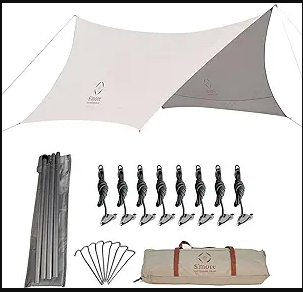Camping is an exhilarating way to connect with nature and create lasting memories, but unpredictable weather can quickly dampen the experience. A well-designed rainfly can be a game-changer, providing essential protection from rain, wind, and moisture, ensuring a comfortable and dry camping experience.
The Importance of a Rainfly
Protecting Your Shelter
A rainfly acts as an additional layer of defense against the elements, shielding your tent from direct rainfall, wind, and condensation. By creating an air gap between the rainfly and the tent body, it helps prevent moisture buildup and keeps your living space dry and comfortable.
Extending the Life of Your Tent
Exposure to harsh weather conditions can take a toll on your tent’s materials, potentially leading to premature wear and tear. A rainfly serves as a protective barrier, shielding the tent from UV rays, rain, and other environmental factors, thus prolonging its lifespan and ensuring you can enjoy it for years to come.
Enhancing Versatility and Functionality
A well-designed rainfly can offer additional functionality beyond just weather protection. Some rainflies can be used as a standalone shelter, providing a lightweight and minimalist option for ultralight backpacking trips or emergency situations.

Materials and Tools Required
Essential Materials
- Waterproof and breathable fabric (e.g., ripstop nylon, polyester taffeta)
- Cord or webbing for guy lines
- Grommet kit or reinforcement patches
- Seam sealer or waterproof tape
Recommended Tools
- Sewing machine or heavy-duty needle and thread
- Scissors or rotary cutter
- Ruler or measuring tape
- Fabric markers or chalk
Step-by-Step Guide to Making a Rainfly
1. Determine the Size and Shape
Measure your tent’s dimensions and decide on the desired shape and size of your rainfly. A common approach is to create a rectangular or trapezoidal rainfly that extends beyond the tent’s footprint, providing ample coverage and space for ventilation.
2. Create a Pattern and Cut the Fabric
Using your measurements, create a pattern on paper or cardboard. Transfer the pattern onto the waterproof fabric and carefully cut out the pieces, leaving extra allowance for seams and hems.
3. Reinforce Stress Points
Identify areas that will experience high stress, such as grommet holes or tie-out points. Reinforce these areas with reinforcement patches or additional layers of fabric to prevent tearing or wear over time.
4. Sew the Panels Together
If your rainfly design requires multiple panels, sew them together using a sturdy thread and a straight stitch or a waterproof seam sealer tape. Ensure that all seams are properly sealed to prevent water infiltration.
5. Add Grommets or Tie-Out Points
Install grommets or create reinforced tie-out points along the edges of the rainfly. These will be used to secure the guy lines or trekking poles, providing stability and tension for the rainfly.
6. Attach Guy Lines or Cord
Cut and attach guy lines or cord to the grommets or tie-out points. Choose a durable and weather-resistant material, such as nylon or polyester cord, to ensure longevity and strength.
7. (Optional) Add Ventilation Features
Depending on your design and preferences, you may want to incorporate ventilation features, such as mesh panels or vents, to improve airflow and prevent condensation buildup inside the tent.
8. Test and Adjust
Once your rainfly is assembled, set it up and test it under various conditions. Observe how it performs in the rain, wind, and sunlight, and make any necessary adjustments to improve its performance or functionality.

Tips for Achieving the Perfect Rainfly
Proper Fabric Selection
Choose a waterproof and breathable fabric that strikes the right balance between protection and ventilation. Ripstop nylon or polyester taffeta are popular choices for their durability, water resistance, and lightweight properties.
Seam Sealing and Waterproofing
Ensuring that all seams and potential entry points are properly sealed is crucial for maintaining the rainfly’s waterproof integrity. Use a high-quality seam sealer or waterproof tape to prevent water infiltration.
Ventilation and Condensation Management
Incorporate ventilation features, such as mesh panels or vents, to promote airflow and reduce condensation buildup inside the tent. This will help maintain a comfortable and dry living space.
Proper Pitching and Tensioning
Correctly pitching and tensioning the rainfly is essential for optimal performance. Follow the manufacturer’s instructions or your custom design guidelines to ensure proper setup and achieve the desired coverage and ventilation.
FAQs (Frequently Asked Questions)
Q: Can I use a tarp or plastic sheeting as a rainfly?
A: While a tarp or plastic sheeting can provide temporary shelter, they are not ideal long-term solutions for a rainfly. These materials lack breathability and can trap moisture, leading to condensation buildup and an uncomfortable living space.
Q: How do I determine the right size for my rainfly?
A: The ideal rainfly size should provide ample coverage beyond the footprint of your tent. A general rule of thumb is to add at least 6 inches (15 cm) of overhang on all sides to allow for proper ventilation and protection.
Q: Can I use a rainfly with a freestanding tent?
A: Yes, rainflies can be used with freestanding tents as well. However, you may need to adjust the design and tensioning system to accommodate the tent’s structure and ensure proper coverage and ventilation.
Q: How do I secure the rainfly to my tent?
A: There are several methods to secure a rainfly to your tent, including using guy lines or trekking poles. Follow the manufacturer’s instructions or your custom design guidelines to ensure proper setup and tensioning.
Q: Can a rainfly be used as a standalone shelter?
A: Some rainfly designs can be used as standalone shelters, providing a lightweight and minimalist option for ultralight backpacking trips or emergency situations. However, not all rainflies are suitable for this purpose, so consult your specific design or manufacturer’s guidelines.
Q: How do I maintain and clean my DIY rainfly?
A: Proper maintenance and cleaning are essential for extending the lifespan of your rainfly. Follow the fabric manufacturer’s recommendations for cleaning and drying. Avoid using harsh chemicals or abrasive materials that could damage the waterproof coating or breathable properties of the fabric.
Q: Can I use a rainfly with a hammock or tarp shelter?
A: Yes, rainflies can be adapted for use with hammocks or tarp shelters. The design and sizing may need to be adjusted to accommodate the unique shape and setup of these shelter types.
Q: Is it possible to make a rainfly for a large or multi-room tent?
A: While it is possible to make a rainfly for larger or multi-room tents, the design and construction process can be more complex. It may require additional materials, reinforcements, and a more intricate tensioning system to ensure proper coverage and stability.
Final Words
Making your own rainfly for your tent can be a rewarding and cost-effective solution to enhance your outdoor adventures. By following the steps outlined in this guide and considering the tips and best practices, you can create a custom rainfly tailored to your specific needs and preferences.
With a little creativity and attention to detail, you can craft a reliable and durable rainfly that will keep you dry, comfortable, and well-protected during your camping trips. Embrace the DIY spirit and embark on this project to elevate your outdoor experience and ensure a memorable and enjoyable time in nature.










